Arum, Cuckoo-pint, Tian Nan Xing 天南星Aron, Wake Robin, Serpentaria Minorus, Dracontia MinorisDa Ba ད་བ (Tibetan Medicine) Chinese Arum (Arisaema): –Tian Nan Xing, Hu Zhang –Zhi Tian Nan Xing (prepared) –Dan Nan Xing (Bile-prepared) |

|

|
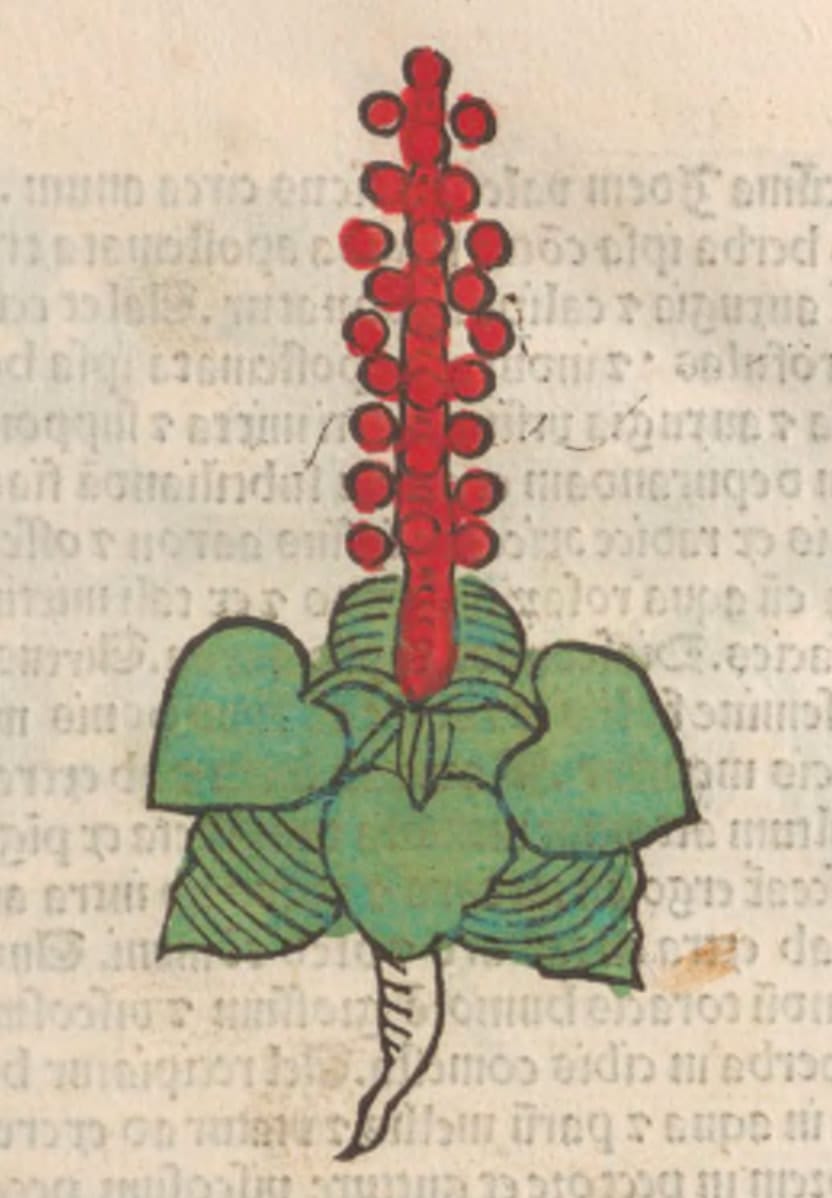 Herbarius latinus, Petri, 1485
Herbarius latinus, Petri, 1485 |
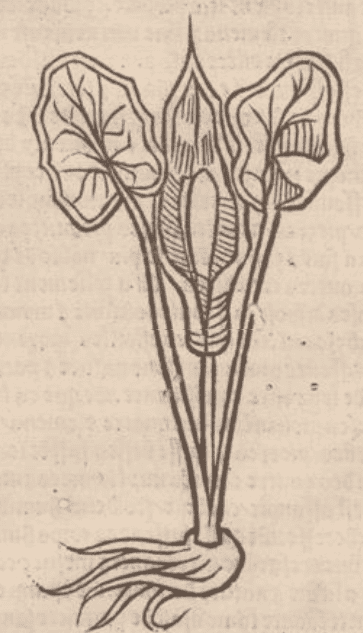 Ortus sanitatis, Cube, Johann von, 1501
Ortus sanitatis, Cube, Johann von, 1501 |
 Arum maculatum
Arum maculatumHerbarum vivae eicones, 1532
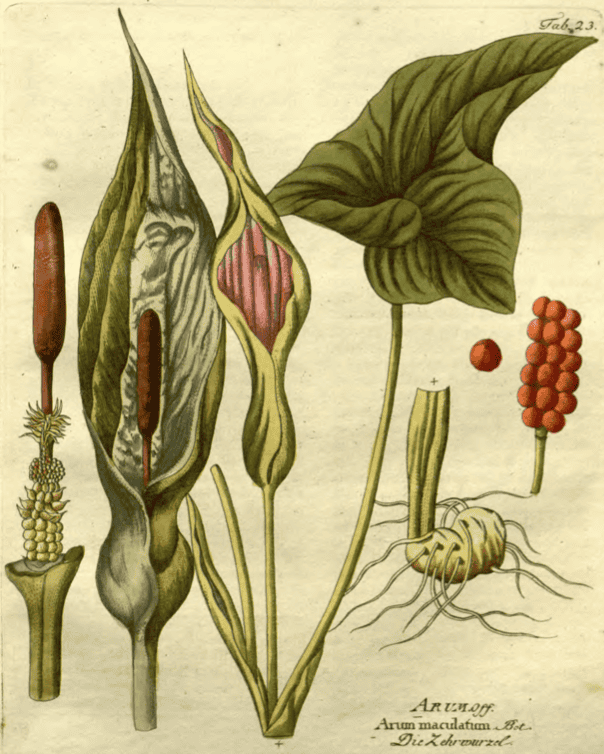 Arum maculatum
Arum maculatumIcones Plantarum Medcio-oeconomico, Vietz, 1800 |
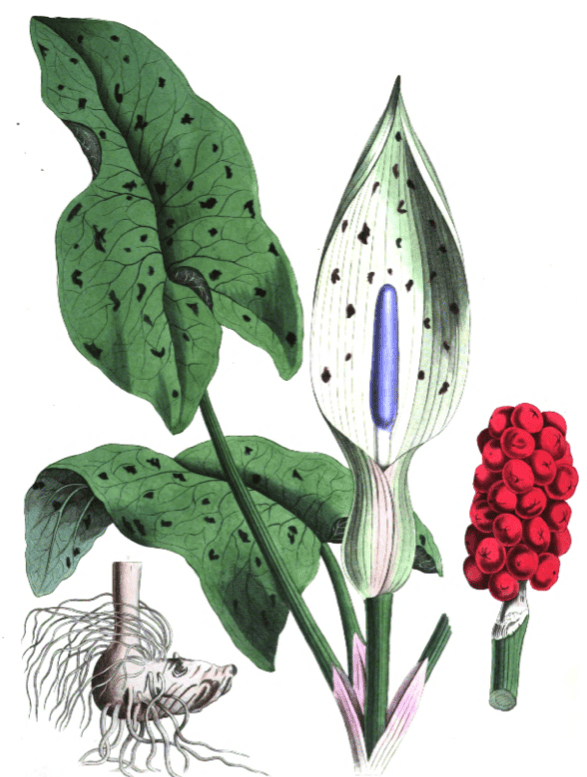 Arum maculatum
Arum maculatumHortus Medicus, Graves, 1834 |
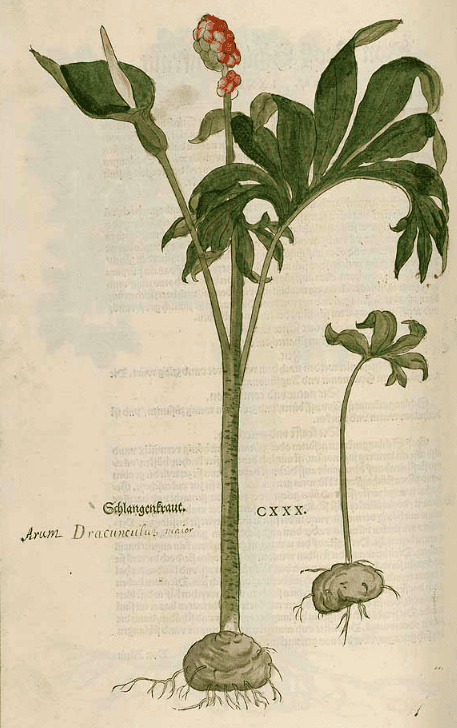
|
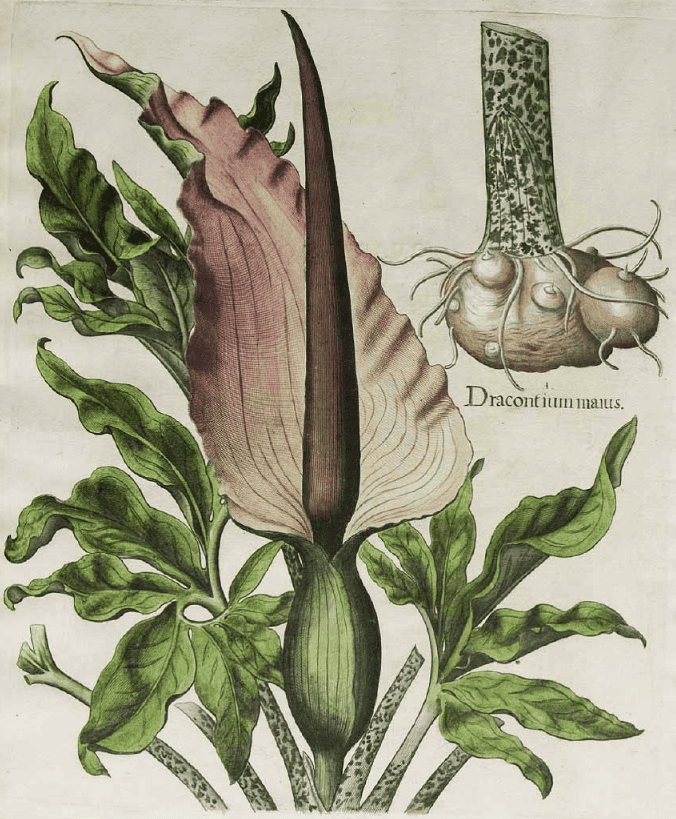
|
|
Arum dracunculus (syn. Dracunulcus vulgaris) L. Fuchs, New Kreüterbuch (1543) |
Arum dracunculus (syn. Dracunulcus vulgaris) Basilius Bessler, Hortus Eystettensis, vol. 2: Quartus ordo collectarum plantarum aestivalium, (1620) |
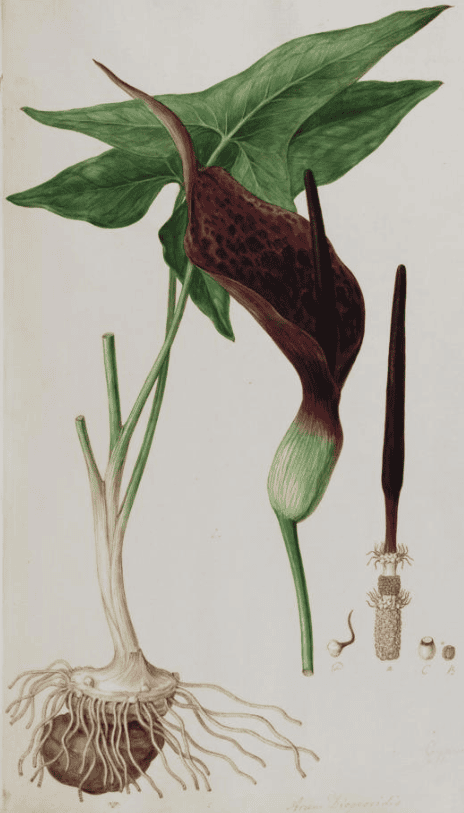 Arum dioscorides
Arum dioscoridesJ. Sibthrop, Flora Graeca (1840) |
|
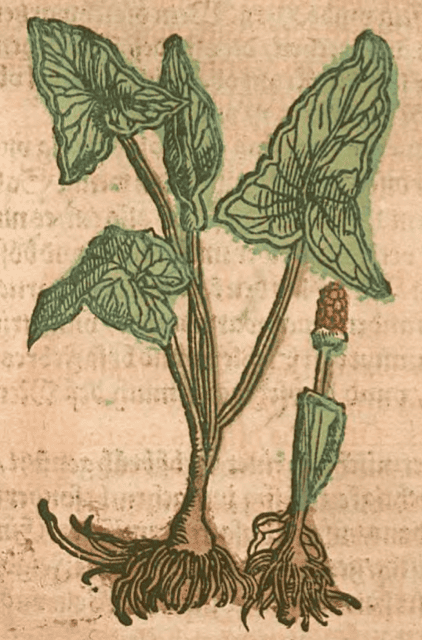
|
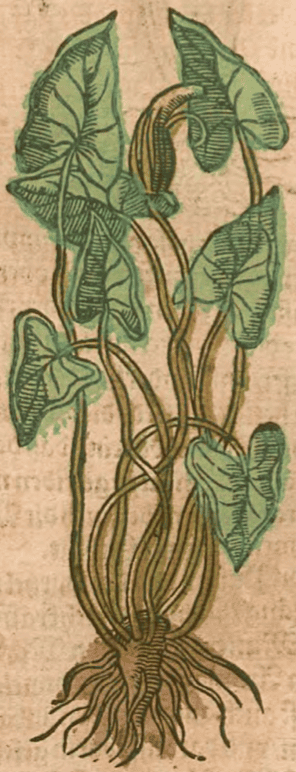
|
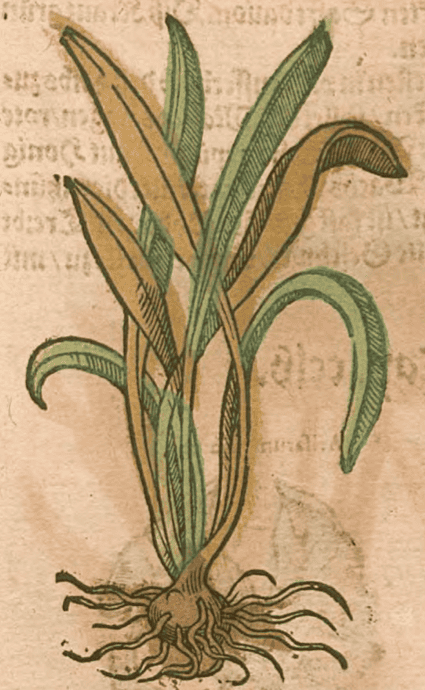
|
Krauterbuch, Lonitzer, 1578
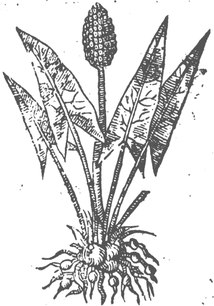
|
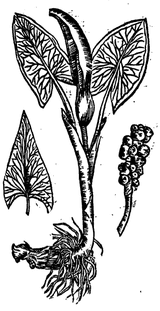
|
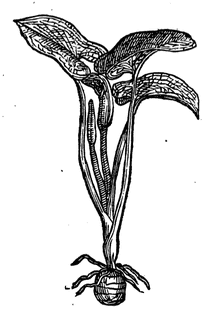
|
|
Lesser Arum Herbario nuovo, 1667 |
Other species of Arum Parkinson, Theatrum Botanicum, 1640 |
The Chinese Arums (Ariseama):
The 2 following species are found in Western China, and are examples of the typical species used in TCM. They are similar in their type and flower, only having a number of leaves per stem, or else deeply divided leaves as opposed to the Western Arum that tends to have one large leaf.
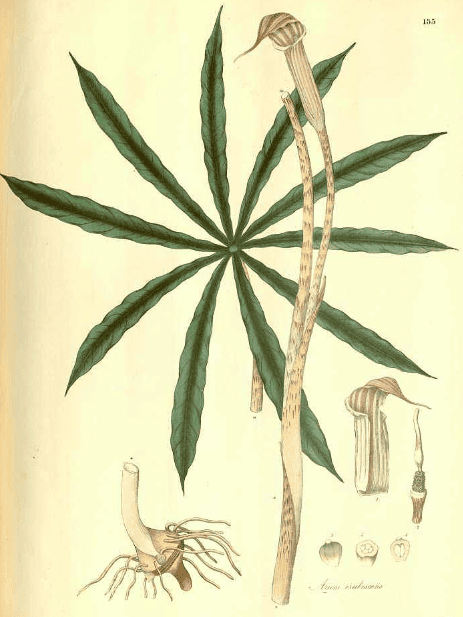
|
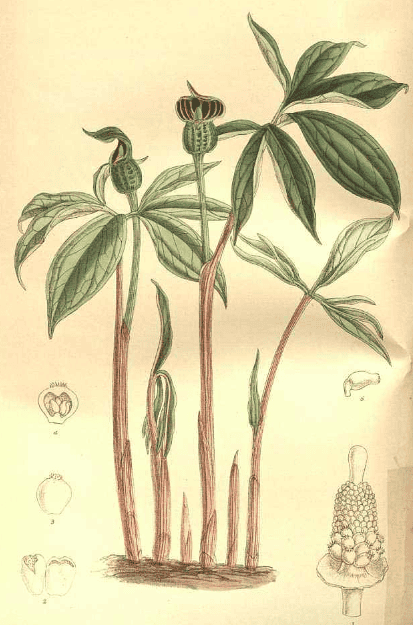
|
|
Arisaema erubescens (as Arum erubescens) Wallich, N., Plantae Asiaticae Rariores, vol. 2 (1831) |
Arisaema flavum (Arum flavum) Curtis’s Botanical Magazine, vol. 126 (1900) |
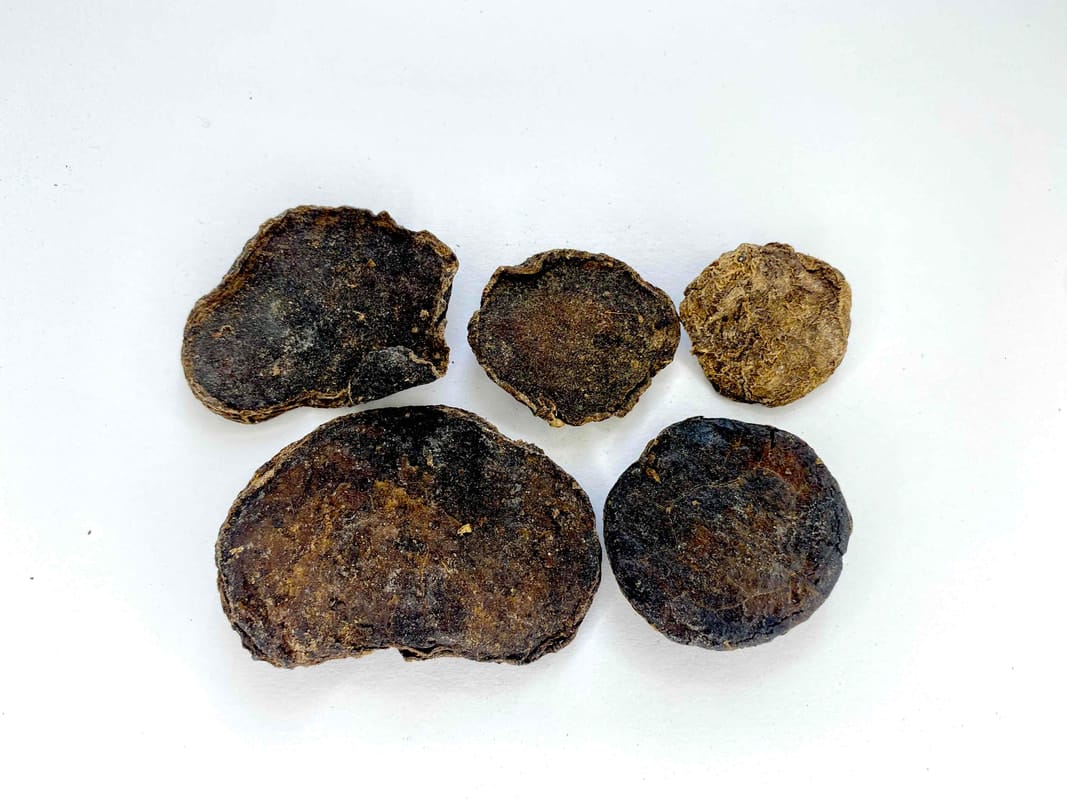 Prepared Arisaema Tian Nan Xing from Chengdu Medicine Market (Adam 2023)
Prepared Arisaema Tian Nan Xing from Chengdu Medicine Market (Adam 2023)Tibetan Arums (Arisaema)
As with the other traditions, a number of species supply Tibetan Medicine, below being two examples. Arum tortuosum (above) which has been used in the West is also used in Tibetan Medicine.
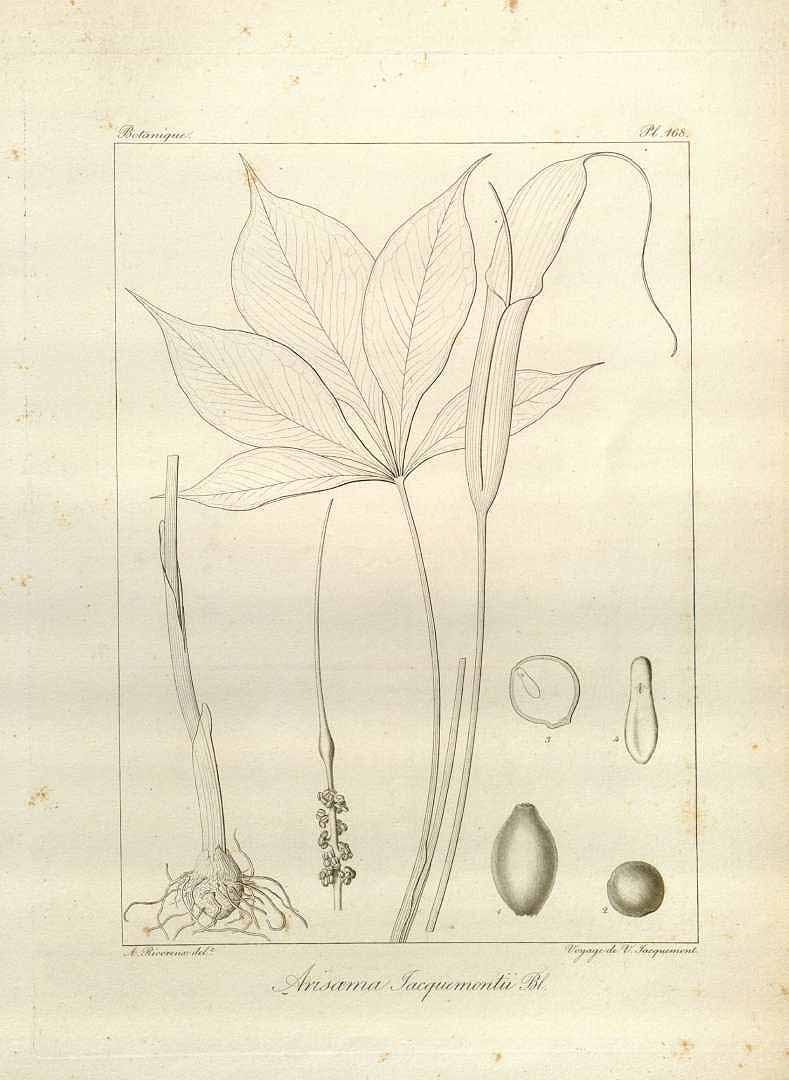
|
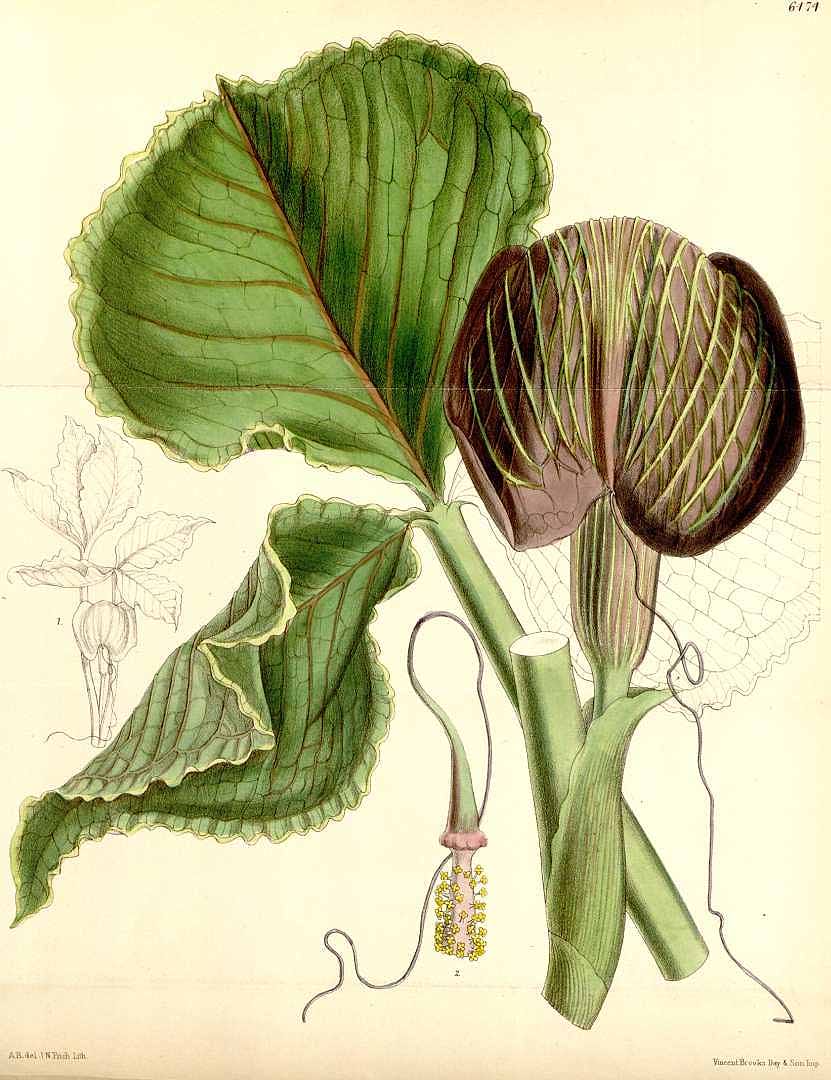
|
|
Arisaema jacquemontii Jacquemont, V., Decaisne,, J., Voyage dans l’Inde pendant les années 1828 à 1832 (1841-1844) |
Arisaema utile Curtis, W., Botanical Magazine (1880) |
Botanical name:
Arum & Ariseama spp.
Arum and Ariseama are very similar and related genus. Often, the two are synonymous, as with the American Jack-in-the-Pulpit or Wake Robin which is known as Ariseame triphyllum, syn. Arum triphyllum. Likewise the Chinese species now classified as Arisaema were previously classed as Arum.
Three varieties of Dracontium were listed in old herbals of the West:
- Dragons; Dracontium major, Dracunculus major, Colubrina magna
- Lesser variety, like Cuckoopint; Dracontium minor, Dracunculus minor, Colubrina magna
- Water Dragons, Dracunculus palustris, Dracunculus aquatilis, Colubrina palustris, Arum palustre
The main species used in the West are:
- A. maculatum (Common Arum, Wake Robin)
- A. vulgare
- A. arisarum (Hooded Arum)
- A. italicum
- A. dracunculus (syn. Dracunulcus vulgaris or Dragon Wort)
- A. dioscoridis
- A. palaestinum
- A. tortuosum
Chinese Arisaema (syn. Arum) spp. (Tian Nan Xing) is derived from:
- A. erubescens
- A. heterophyllum
- A. amurense
- A. flavum
- A. yunnanense
- A. lobatum
- A. consanguineum
- Zhi Tian Nan Xing prepared root obtained from TCM herbalists
- Dan Nan Xing (Bile-prepared Arum) is preferred for Wind-Phlegm Spasms and nervous conditions, .
In Tibetan Medicine, Da Ba is obtained from:
- Arisaema flavum
- A. intermedium
- A. lobatum
- A. consanguineum
- A. utile
- A. tortuosum
- A. jacquemontii, and others
Comment:
It is premature to say all the above species are synonymous. However, the genus is regarded as Hot and dry and toxic with pungent and bitter taste. In East and West they are all used to cut through tough and Cold-Phlegm, and are used for Cold-Phlegm Lung diseases as well as Tumors and Masses from Cold-Phlegm obstruction. In each system, when the root is used it is prepared to detoixify it. Therefore, we believe the prepared Chinese Tian Nan Xing is a suitable and perhaps safer form of this medicine to use, especially when used to clear tough, cold phlegm and resolve thickness and tumors.
Parts used:
Prepared Root
Rarely, the leaves or seed are used.
Temperature & Taste:
Hot, dry, Pungent, Bitter. Toxic
It is particularly Pungent and irritant when fresh, but loses much on drying and becomes a little mucilaginous. The Pharmacopoeia Universalis (Jourdan, 1833) went as far as to say the dried root is ‘nearly inert’.
Resolves, discusses
Classification:
2F. PURIFYING. 2M. DRAWING
3K. EXPECTORANT. 3L. ANTI-TUSSIVE
4d. PECTORAL
TCM:
P. Clear Cold Phlegm
Uses:
1. Clears Cold-Phlegm and Damp (West, TCM):
-Cough, Asthma, Wheezing, chest Pain
-praised for Pleurisy, Pneumonia, Purulent expectoration (taken with Honey)
-for these purposes, powdered root can be made into an Electuary with Honey (Pliny)
-Cough, Wheezing, decoct and add Honey (Botanicon Continens Herbarum, Dorsten, 1540)
-poor appetite, nausea and abdominal distention from Cold-Phlegm (taken with Oxymel, Pliny)
-“In cases of orthopnoea and chronic asthma it should be taken after repeated boiling till its (other) medicinal properties are lost”. (Avicenna)
2. Warms the Kidneys, Clears Damp, Opens Obstructions (West, TCM):
-opens obstructions and promotes Urine
-Hernia
-“Cuckoo-pint, if taken with wine, stimulates sexual desire, cleanses the kidneys” (Avicenna)
-enhances Male Sex Drive (Kai Bao Ben Cao, TCM)
3. Clears Phlegm, Moves the Blood, Resolves Masses (West, TCM):
-Scrofula, Tumors, Fibroid Tumors, Hard Lumps and Cancers
-‘dissolve subscutaneous nodes’. (Li Shi Zhen); ‘Dissolve Blood Stasis’ (Kai Bao Ben Cao)
-‘dissolve stagnation of pathogenic Cold and Heat’. (Shen Nong Ben Cao)
-internal Bruising and congealed Blood.
-promotes Menstruation, clears Afterbirth (Hippocrates)
-‘relieves Heart pain’ (Shen Nong Ben Cao Jing, TCM)
-in Tibetan Medicine, Arisaema flavum is used for swellings, and also to stop excess bone growth following setting a fracture. (Drungtso)
-flower is used in Tibetan Medicine for womb diseases, and to dilate Cervix. (Norbu)
-“taken orally with honey to clear the freckles, lentigo, pityriasis and red spots” (Avicenna)
4. Clears Wind-Phlegm, Stops Spasms (West, TCM):
-Wind-Cold-Phlegm conditions affecting the Brain and Nerves
-Dizziness, Vertigo, Apoplexy, Paralysis, Numbness, Hemiplegia, Lockjaw and Convulsions from Wind-Phlegm. (TCM)
-the root is usually, although not always, prepared with Cow Bile (Dan Nan Xing) for this purpose in TCM.
-relieves Melancholy and Sadness, and generates Blood (Botanicon Continens Herbarum, Dorsten, 1540)
–Hildegard likewise said Arum boiled in wine cured Melancholy, a ‘Fierce Mind’ and Sadness.
5. Resists Poison (West):
-used in Antidotes
-bites of venomous Snakes (West & TCM: Da Ming)
-the root is taken for toxic and black Sores, Boils, Carbuncles (Botanicon Continens Herbarum, Dorsten, 1540)
-root was eaten during times of Epidemics at the time of Hippocrates
-‘Epidemic diseases’ (Zhen Quan)
-‘when the crude drug is used, it oppresses Realgar, Cinnabar and Niter’. (Li Shen Zhen)
-fruit is used for Poison in Tibetan Medicine
6. Externally:
-distilled water is a good cosmetic removing spots of the face and making the skin shiny.
-root with honey applied to remove freckles.
-also to remove films of the eyes (with Honey)
-topically to Piles
-topically to Warts
-the juice is excellent for all types of Ulcers, including Cancerous Ulcers (Pliny, Tibetan Medicine)
-‘applied to treat Scabies, Tinea and Malignant Sores’. (Da Ming, TCM)
-used for excess granulation in healing Wounds and Ulcers (Tibetan Medicine)
-topically for Phlegm swellings and Masses (the unprepared, dried root is usually used)
-topically applied to Fractures and Dislocations
-used to prevent bony growth and outward growth of bones after bone-setting (Tibetan Medicine)
-applied to the genitals to promote Labor (Classically–should not be repeated)
-fresh leaf beaten with Honey is applied to Abscesses (Hippocrates)
-leaves boiled in Honey are applied to sprains (Pliny)
-leaves with wine and oil are applied to Burns (Pliny)
-leaves beaten with Salt and applied to Arthritic joints (Pliny)
-applied to Toothache from caries. (TCM)
Preparation:
Western writers noted that the fresh root contains a milky, acrid irritant juice, but this was greatly reduced when dried. Some ancient authors considered such medicines ‘prepared’ after they had been kept for a certain amount of time. A year or two after drying, the roots are far less irritant.
Li Shi Zhen said ‘processed with Fire, it is nontoxic’.
The root is prepared and safe for internal use when it doesn’t cause a tingling sensation on the tongue when tasted.
1. Vinegar-Prepared Arum:
In the Western Tradition Arum is prepared by slicing, steeping overnight in vinegar, then drying. Some would dry or partly dry the root before infusing in vinegar while others appeared to put the fresh root directly into vinegar. After steeping in vinegar they should be dried quickly which can be achieved by patting them dry, then heating in an oven at around 80 degrees C. for an hour or so.
2. Prepared Arisaema Zhi Tian Nan Xing (TCM)
Prepared by steeping the root in water for a couple of days, changing the water several times each day, then Alum is added to the water and soaked another day. Then fresh Ginger and Alum are decocted together and the root is boiled with them. The root is sliced and dried. This greatly reduces toxicity and makes its stronger to clear Phlegm and Damp (Bensky). The use of Alum serves to counter the Hot poison, as well as adding to the drying and phlegm-relieving effect.
Traditionally, the root was simply soaked in water for 7 days, changing the water 3 or 4 times daily, then washing well and drying in the sun, or roasting on the fire until it cracks. (Su Song, TCM)
Li Shi Zhen said the root should be washed in warm water, then soaked in a solution of Alum for 3 days and nights, then dried in the Sun.
3. Ginger-Prepared Arisaema Zhi Tian Nan Xing (TCM)
Wrap the drug with fresh Ginger, then roast in a fire. When it is well cooked, remove the Ginger skin and bake the root until dry. This is best when used for conditions with Spleen deficiency. (Li Shi Zhen)
4. Bile-Prepared Arisaema Dan Nan Xing (TCM).
The prepared Root is powdered and mixed with Cow or Pig bile, then steamed, cut and dried. Or it is fermented with Bile, then steamed and dried. This is not prepared by practitioners by is factory-made. It is regarded as stronger the longer it is stored. It is stronger for Phlegm-Heat and Wind, stops Tremors; used for Childhood Convulsions, Tremors, Seizures, Convulsions, after Strokes etc.
Li Shi Zhen gives the following method: mix powdered Arisaema Tian Nan Xing with Bull Bile, then insert it into the Gall Bladder, seal it and hang up in a windy place to dry. ‘The longer it is kept there, the better its quality’.
5. Fermented Arisaema Nan Xing Qu (TCM)
Mix powdered Arisaema Tian Nan Xing with Ginger juice and Alum to form little cakes. Put them in a basket and cover with Mulberry leaves. A yellow coating will appear over the cakes. Then dry them in the sun and keep for use.
6. Scorched Arisaema (Chao Tian Nan Xing)
Small pieces of the root can be dry-fried until lightly scorched. ‘When processed with fire, it is non toxic’. (Li Shi Zhen)
7. Unprepared Root:
The unprepared, dried root is only used in some external medicines.
Dose:
Pliny mentions the root being decocted in milk for Ulcers of the Intestines.
Of the Vinegar-Prepared Root in Powder (West): 5–10 grains (325–650mg), to 20 grains (or half dram);
The prepared root powder mixed with twice its weight of Sugar or Honey and formed into an Electuary was taken in doses of 1–2 drams.
Of the Prepared Chinese Root (Zhi Tian Nan Xing) in powder: 500mg–1.5 grams
Of the Prepared Chinese Root (Zhi Tian Nan Xing) in decoction: 3–9 grams (15–45 grams have been used for Cancer but these should be build up to gradually)
Comment:
The Arum / Arisaema species of the East and West have been used quite similarly. As the Chinese product is easily available and has been prepared both to reduce toxicity and enhance the effect of clearing Phlegm and Damp, it can be used in places where Arum is called for in western formulas.
Substitute:
1. The Chinese Tian Nan Xing can be used in place of the western Arum and is synonymous with the Tibetan Arums.
2. Pinellia pedatisecta is recognised as a variant of Tian Nan Xing (Encylclopedia of TCM)
3. When used for Cold-Phlegm, Pinellia Ban Xia may be used. (Wang Hao Gu, TCM)
Corrective:
1. Taken with Saposhnikovia Fang Feng, it is no longer tingling. This combination is most useful for Wind-Phlegm. (Li Shi Zhen)
2. Fresh Ginger is also used to correct.
Main Combinations:
1. Arisaema Tian Nan Xing with Citrus Chen Pi
In TCM, Prepared Arisaema Zhi Tian Nan Xing is combined with Citrus peel Chen Pi and Pinellia Zhi Ban Xia for Cold-Phlegm obstructing the Chest with Cough, Wheezing and hard-to-clear Phlegm.
2. Arisaema Tian Nan Xing with Phellodendron Huang Bai
Arisaema Zhi Tian Nan Xing is combined with Phellodendron Huang Bai to lead its activity to the lower body.
In the West, prepared Arum was commonly used with Calamus for Phlegm-Damp, and especially for the Stomach, but also for the Brain and Nerves. In these cases Dan Nan Xing is a better choice.
Phlegm-Damp
1. Cough:
i. from Phlegm-Heat obstructing the Lung, prepared Arisaema Zhi Tian Nan Xing with Scutellaria Huang Qin.
ii. from Phlegm-Cold, prepared Arisaema Zhi Tian Nan Xing with Citrus Chen Pi, Ginger, Licorice
iii. Wind-Phlegm Cough, boil prepared Arisaema Zhi Tian Nan Xing powder (3 grams) with fresh Ginger (3 slices) down to half. (Shi Quan Bo Jiu Fang, TCM)
iv. from excess Cold Phlegm, prepared Arisaema Zhi Tian Nan Xing with Pinellia Ban Xia, Citrus Chen Pi. If the cold is more severe, substitute Chen Pi with Cinnamon. (TCM)
2. Phlegm-Damp diseases:
i. Arum rarely appears in Western formulas; it appears in Antimoron of Nicholas.
3. Phlegm-Damp affecting the Stomach:
i. prepared Arum with Calamus (West)
ii. prepared Arisaema Zhi Tian Nan Xing with Poria Fu Ling, Citrus Chen Pi
iii. prepared Arisaema Zhi Tian Nan Xing with Galangal (Gao Liang Jiang), Amomum Sha Ren (Tai Ping Hui Min He Ji Ju Fang, TCM)
4. Vomiting and Diarrhea with cold extremities from Wind attack in a deficient condition:
i. Apply powdered Arisaema Tian Nan Xing to teh sole of the foot. (Pu Ji Fang, TCM)
ii. Prepared Arisaema Zhi Tian Nan Xing (9 grams), Red Dates (Da Zao) (3 pieces). Boil down to half and take as a dose. (Ji Xiao Fang, TCM)
Wind-Phlegm disease of the Nerves and Head
5. Wind-Phlegm Dizziness, Seizures, Vertigo, Bile-Prepared Arisaema Dan Tian Nan Xing with Gastrodia Tian Ma.
6. Headache from Wind-Phlegm, Prepared Arisaema Zhi Tian Nan Xing and Schizonepeta Jing Jie (equal parts). Powder and make pills the size of parasol seeds with Ginger juice. Take 20 pills after food with decoction of Ginger. (Jing Xiao Ji Shi Fang, TCM)
7. Vertigo from Wind-Phlegm, with blurred vision, nausea, Prepared Arisaema Zhi Tian Nan Xing, Pinella Zhi Ban Xia (30 grams each), Gastrodia Tian Ma (15 grams), Wheat Flour (90 grams). Powder, mix with water, form pills the size of parasol seeds. Take 30 pills with fresh Ginger Decoction. (Tai Ping Hui Min He Ji Ju Fang, TCM)
8. Epilepsy from Phlegm:
i. with deficiency, Arisaema Tian Nan Xing with decoction of Ginseng
ii. with excess Phlegm, Arisaema Tian Nan Xing with Calamus (Shi Chang Pu), Ophiopogon Mai Men Dong. (from Wei Sheng Bao Jian, TCM)
iii. Give the powder with Pig Bile. (Quan You Xin Jian, TCM)
iv. roasted Arisaema Tian Nan Xing (30 grams), Cinnabar (3 grams), powder and form pills the size of a parasol seed with Pig’s Heart Blood. To take, dissolve one pill in decoction of Saposhnikovia Fang Feng. (Pu Ji Fang, TCM)
9. Apoplexy:
i. Prepared Arisaema Zhi Tian Nan Xing is mixed with equal amounts of Borneo Camphor (Bing Pian) and powdered. To use it is rubbed on the teeth 20 or 30 times. Even if the jaw is closed shut, the mouth will open. (Jing Yan Fang, TCM)
ii. Prepared Arisaema Zhi Tian Nan Xing decocted with Costus Mu Xiang, and fresh Ginger. (Wang Shuo Yi Jian Fang, TCM)
iii. Prepared Arisaema Zhi Tian Nan Xing with Ginseng, Calamus (Shi Chang Pu). (from Zhi Zhi Fang, TCM)
iv. Roasted Arisaema Tian Nan Xing (9 grams) with fresh Ginger (5 slices), Perilla leaf (Zi Su Ye) (3 grams). Decoct to half, add a little Pig Bile and drink warm. (Ren Zhai Zhi Zhi Fang, TCM)
v. Raw, dried Arisaema Tian Nan Xing (30 grams), Costus (Mu Xiang) (0.3 gram), raw, dried and peeled Aconitum Chuan Wu (3 grams), raw, dried and peeled Acontium Fu Zi (15 grams). Powder and decoct 15 grams with 15 slices of fresh Ginger root to be taken orally over the course of a day for hemiplegia and deviation of the eyes and mouth. (This formula is called San Sheng Yin)
10. Infantile Lockjaw:
i. Prepared Arisaema Zhi Tian Nan Xing is mixed with equal amounts of Borneo Camphor (Bing Pian) and powdered. To use it is rubbed on the teeth 20 or 30 times. Even if the jaw is closed shut, the mouth will open. (Jing Yan Fang, TCM)
ii. rub the teeth with crude Arisaema Tian Nan Xing and fresh Ginger. The mouth will open. (Jing Yan Fang, TCM)
11. Infantile Convulsions, scorched Arisaema Tian Nan Xing, Gastrodia Tian Ma, powder, add a little Musk, and take with Decoction of fresh Ginger and Saposhnikovia Fang Feng.
12. Deviation of the mouth and eye, mix crude Arisaema Tian Nan Xing with Ginger juice and apply on paper to the opposite side of the face to the deviation (Ren Cun Fang, TCM). However, in another text (Yang Shi Jia Cang Fang) the same formula is used for deviation of the eye and mouth from facial paralysis and it is applied to the same side.
13. Mental Confusion, Roasted Arisaema Tian Nan Xing with Amber (Hu Po), Cinnabar (Zhu Sha), formed into Pills. (Tai Ping Hui Min He Ji Ju Fang, TCM)
14. Alcoholism, Roasted Arisaema Tian Nan Xing with Cinnabar (Zhu Sha) are formed into pills with flour and Ginger juice. (Yang Shi Jia Cang Fang, TCM)
Scrofula, Nodes, Tumors, Cancer
15. Scrofula and hard Nodes:
i. Arum and Figwort
ii. Arum applied with Honey (Hippocrates)
iii. Arum with Squill as a plaster in pig fat. (Botanicon Continens Herbarum, Theodore Dorsten, 1540)
iv. fresh Arisaema Tian Nan Xing (1 root) is beaten to a paste with 5–7 drops of vinegar and applied after first pricking the node to allow the drug to penetrate. (Yan Zi Li Ji Sheng Fang, TCM)
16. Cancer:
i. Prepared Tibetan Arisaema spp., prepared Nux Vomica, Cinnabar (Tibetan Folk remedy: personal communication from Tibetan healer; Adam)
ii. Prepared Arum palaestinum, Wild Rue, Turmeric (this is a modern combination that has been researched with good results)
iii. Arum root powder (4 parts), crystal Arsenic (1 part); sprinkled topically. (Platerus Golden Practice of Physick, Plater, 1664)
iv. Cervical Cancer, a strong decoction (15–45 grams) has been used internally while used suppositories or douches topically. (Chen & Chen)
Other
17. Pestilence (Plague, Infection), the root is taken with Theriac (Botanicon Continens Herbarum, Theodore Dorsten, 1540)
Externally
18. To clear the face and roughness of the skin, beat the root with Cuttlefish bone and mix with Rose water and applied. (Botanicon Continens Herbarum, Theodore Dorsten, 1540)
19. Films of the Eyes, the juice combined with Honey is applied (Pliny)
20. Warts, mix Arisaema Zhi Tian Nan Xing powder with Vinegar to a paste and apply. (Jian Yi Fang, TCM)
21. To strongly promote Menstruation, Arum with Myrrh and Laudanum as a pessary.
Major Formulas:
Antimoron (Nicholas)
Dao Tan Tang
Ding Xian Wan
Qing Qi Hua Tan Wan
Shang Zhong Xia Tong Yong Tong Feng Wan
San Sheng Yin
Xiao Huo Luo Wan
Yu Zhen San
1. Stomach Powder:
Generally used as an antacid, and for Stomach pain.
i. Arum, Calamus (3 drams), Canella (2 drams); powder. Dose: 20–30 grains
ii. Arum root (2 drams), Calamus (3 drams), Potassium sulphate (1 scruple)
iii. Birkmann’s Stomach Powder (For excess acidity): Arum root (20 parts), Calamus (10 parts), Saxifrage root, Cinnamon, prepared Oyster shells, Sodium bicarbonate (5 parts each). (Hager’s)
iv. Arum (2 drams), Calamus, Burnet Saxifrage (of each 3 drams), Cinnamon (2 scruples), Potassium Sulphate (2 drams) (Pharmacopoeia Amstelodamensis, 1792)
v. Arum, Calamus, Burnet Saxifrage (48 parts each), Crab’s Eyes (12 parts), Cinnamon (9 parts), Potassium sulphate (6 parts), Ammonium chloride (2 parts). Dose: 2–4 drams.
Cautions:
1. Irritant and toxic when fresh, not dried properly, or taken in overdose. Only the processed root is used internally.
2. Not suitable for Yin deficient (dry) conditions or conditions with strong Heat.
3. Not used during Pregnancy.
4. As it is toxic to the Liver its use should be avoided in those with Liver disease.
Drug Interaction:
1. It has a marked sedative effect an may poteniate sedative medication including barbituates
Toxicity:
1. Overdose or ingestion of the unprepared herb may result in numbness of the mouth, burning tongue, loss of taste, nausea, headaches, dizziness, palpitations and slurred speech. More severe toxic symptoms results in spasms, convulsions and respiratory depression. Doses as little as 10 grams have been associated with mild toxic symptoms.
2. Some people have had allergic reactions to this herb.
Antidotes:
1. Vinegar can be given.
2. Vinegar and Ginger juice.
3. Saposhnikovia Fang Feng removes its tingling quality (Li Shi Zhen)
4. Decoction of fresh Ginger (30 grams), Saposhnikovia Fang Feng (60 grams), Licorice (15 grams) has been successfully used in overdose.
Main Preparations used:
Prepared Root, Electuary (powdered root with Honey), Conserve (fresh root with Sugar), Fecula of Arum (Arum Starch)
Conserve of Common Arum:
Root, bruised to a pulp (1 part), Sugar (2 parts)
Beat well. Some used one part root to 3 parts sugar.
Fecula of Arum (Arum Starch):
Grate the root, put into a linen bag and press hard. Add a little water to the juice and set aside. Pour of the clear water and dry the sediment with a moderate heat, then powder and keep.
Pliny on Arum maculatum:
|
‘The Greeks themselves, in fact, have established an immense difference between these two plants, in attributing to the seed of the dracunculus certain hot, pungent properties, and a fetid odour so remarkably powerful as to be productive of abortion, while upon the aron, on the other hand, they have bestowed marvellous encomiums. As an article of food, however, they give the preference to the female plant, the male plant being of a harder nature, and more difficult to cook. It carries off, they say, all vicious humours from the chest, and powdered and taken in the form either of a potion or of an electuary, it acts as a diuretic and emmenagogue. Powdered and taken in oxymel, it is good for the stomach; and we find it stated that it is administered in ewe’s milk for ulcerations of the intestines, and is sometimes cooked on hot ashes and given in oil for a cough. Some persons, again, are in the habit of boiling it in milk and administering the decoction; and it has been used also in a boiled state as a topical application for defluxions of the eyes, contusions, and affections of the tonsil lar}- glands. (Indetermined) prescribes it with oil, as an injection for piles, and recommends it as a liniment, with honey, for freckles. ‘Cleophantus has greatly extolled this plant as an antidote for poisons, and for the treatment of pleurisy and peripneumony, prepared the same way as for coughs. The seed too, pounded with olive oil or oil of roses, is used as an injection for pains in the ears. Dieuches prescribes it, mixed in bread with meal, for the cure of coughs, asthma, hardness of breathing, and purulent expectorations. Diodotus recommends it, in combination with honey, as an electuary for |
phthisis and diseases of the lungs, and as a topical application even for fractured bones. Applied to the sexual parts, it facilitates delivery in all kinds of animals; and the juice extracted from the root, in combination with Attic honey, disperses films upon the eyes, and diseases of the stomach. A decoction of it with honey is curative of cough; and the juice is a marvellous remedy for ulcers of every description, whether phagedenic, carcinomatous, or serpiginous, and for polypus of the nostrils. The leaves, boiled in wine and oil, are good for burns, and, taken with salt and vinegar, are strongly purgative; boiled with honey, they are useful also for sprains, and used either fresh or dried, with salt, for gout in the joints. ‘Hippocrates has prescribed the leaves, either fresh or dried, with honey, as a topical application for abscesses. Two drachmae of the seed or root, in two cyathi of wine, are a sufficient dose to act as an emmenagogue, and a similar quantity will have the effect of bringing away the after-birth, in cases where it is retarded. Hippocrates used to apply the root also, for the purpose. They say too, that in times of pestilence the employment of aron as an article of food is very beneficial. It dispels the fumes of wine; and the smoke of it burnt drives away serpents, the asp in particular, or else stupefies them to such a degree as to reduce them to a state of torpor. These reptiles also will fly at the approach of persons whose bodies have been rubbed with a preparation of aron with oil of laurel: hence it is generally thought a good plan to administer it in red wine to persons who have been stung by serpents. Cheese, itis said, keeps remarkably well, wrapped in leaves of this plant. |
| ‘There is a plant also called the ” arisaros ” which grows in Egypt, and is similar to the aron in appearance, only that it is more diminutive, and has smaller leaves; the root too is smaller, though fully as large as a good-sized olive. The white arisaros throws out two stems, the other kind only one. They are curative, both of them, of running ulcers and burus, and are used as an injection for fistulas. The leaves, |
boiled in water, and then beaten up with the addition of oil of roses, arrest the growth of corrosive ulcers. But there is one very marvellous fact connected with this plant— it is quite sufficient to touch the sexual parts of any female animal with it to cause its instantaneous death. (The Natural History of Pliny, trans. by Bostock and Riley, Vol. 5, 1856) |
Arisaema spp.

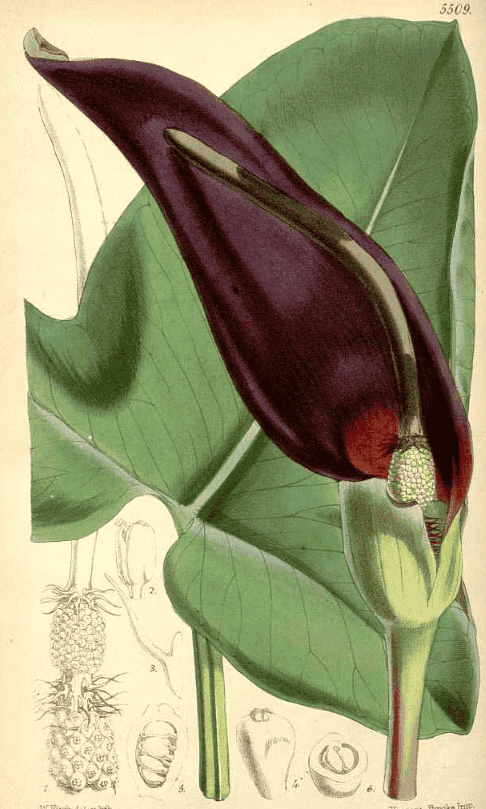 Arum palestinum
Arum palestinum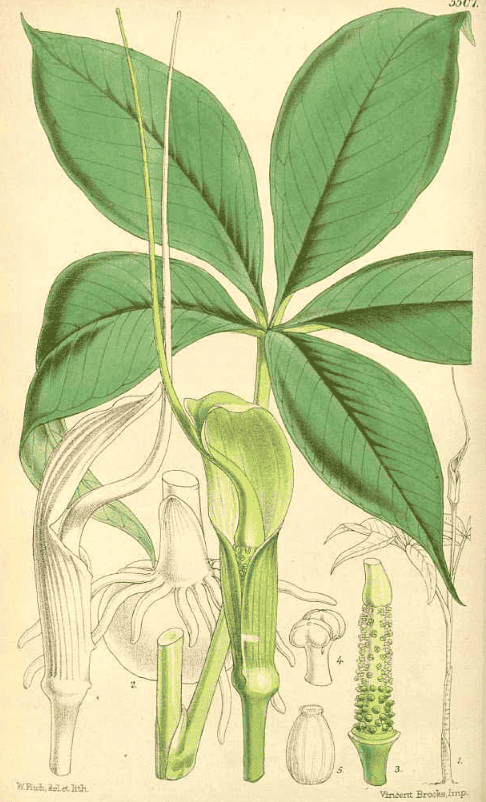 Arum tortuosum
Arum tortuosum